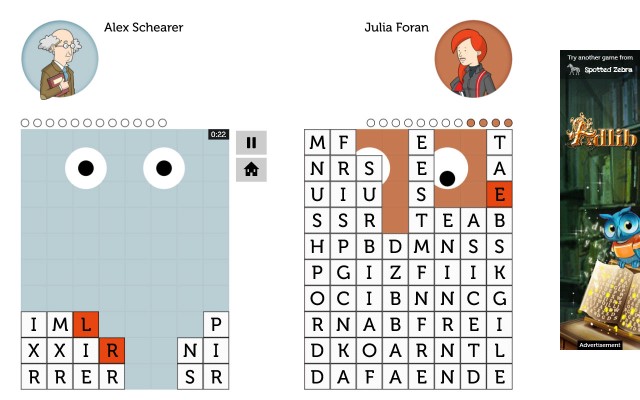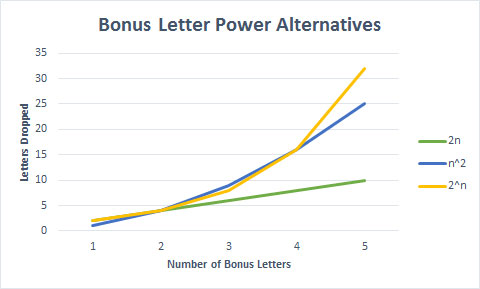Having decided that you would interact with your opponent by dropping letters on her board the question became how? Different answers to this question resulted in very different gameplay and not all of them being equal. When designing the attack system in Scramble Legends I had three goals in mind:
- Reward skillful play, in particular reward you for spelling longer words
- Encourage thinking ahead and force you to make trade-offs
- Ensure that a match ends in a reasonable number of turns
With these goal in mind, I tried a number of variations before settling on the final solution.
Attack on Level Complete
Because Scramble Legends started its life as Adlib, it initially featured many of Adlib’s gameplay elements. At the time Scramble Legends still sported the concept of score and levels – you would reach a new level based on your score, and at the end of each level your board would be reset. At that time, I felt that completing a level was a natural opportunity to drop letters on your opponent. It turns out I was totally wrong!
When you play Scramble Legends you clear a level every few minutes – completing more than one per a turn was rare. As a result with this attack scheme you would only drop letters on your opponent every two or three turns. In practice, matches dragged on too long and also lacked a sense of excitement.
That wasn’t the only problem, either. Tying attacks to level completion gave you zero control over the power of your attacks. Playing well simply meant clearing levels as quickly as possible – each time dropping a set number of letters on your opponent. In Scramble Legends I want you to play skillfully and plan ahead in order to dominate your opponent – dropping letters on level complete failed to encourage this style of gameplay.
Attack for each Word
Having given up on level completion in large part due to its poor feedback loop I started looking for events which happened more frequently. Naturally word completion jumped to the top of the list. Spelling words is the main activity in Scramble Legends and scales for various skill levels. Initially I tried dropping as many letters as you removed with each word. So spelling a five letter word dropped five letters on your opponent. As you might imagine that proved to be much too powerful and games typically ended in one or two turns.

Next I tried dropping a single letter for each word you spelled. In a typical turn you might spell eight or ten words thus dropping roughly one row’s worth of letters on your opponent. While this change was on the right track I found it was still too powerful. If you went first you could easily fill up your opponent’s board with many letters overwhelming her when she started her turn. In addition, I found matches tended to settle into a kind of equilibrium between you and your opponent. You would start a new turn with a packed board, spell many words to clear your board, and fill your opponent’s boards in the process – but all the while neither you nor your opponent would pull ahead.
Attack with Bonus Letters
With the last attempt I felt I was on to something. However the balance was not quite right and as a result matches tended to feel never ending. So I tried to tweak the available variables to get a better result. I could vary the strength of an attack by:
- Whether the word is part of a chain reaction
- Using bonus letters
- Word’s score
Because I decided to drop score from the game entirely the third option was off the table. As a result, the purpose of bonus letters was in doubt. Before they multiplied a word’s score, but what now? Make them responsible for attack strength of course! Furthermore, by combining multiple bonus letters in a single word you can multiply the power of your attack. This provides a great opportunity to plan ahead and unleash a super powerful attack.

When I started working on Scramble Legends I really lacked a clear picture of how you would interact with your opponent. The target emotions I wanted Scramble Legends to evoke acted as a guide and helped direct my design. In the end, Scramble Legends is all about hectic, skillful competition with your friends!
- User Interface: a look at how the user interface was designed
- Avatar Style: follow the evolution of Scramble Legends' art style
- Making the Avatars: guest post by Kyle McGill artist for Scramble Legends
- Avatar Design: learn how the avatar art style was finalized
- End Game Condition: explore the thought process behind the game's end game condition
- Attack Design: understand why Scramble Legends is all about burying your opponent
- Overdrive Mode: a look at the design and technical considerations behind this special game mode
- Sound Design: guest post by David Kizale sound designer for Scramble Legends

